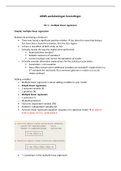College aantekeningen
Hoorcollege aantekeningen ARMS Advanced Research Methods And Statistics ()
Dit document is een zeer uitgebreide samenvatting van alle hoorcolleges van ARMS, die ik erg zorgvuldig heb geluisterd online. Alle informatie is tot in de details uitgetypt, daarom is het document groot. Ik heb zelf dankij mijn aantekening een 7,8 gehaald, al ben ik niet goed in statistiek.
[Meer zien]




